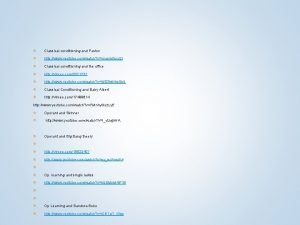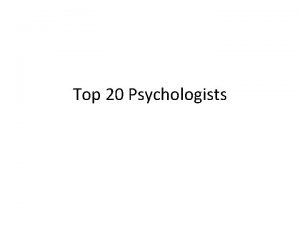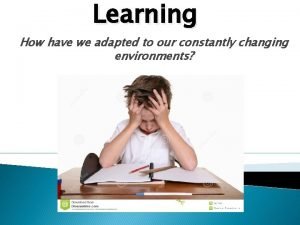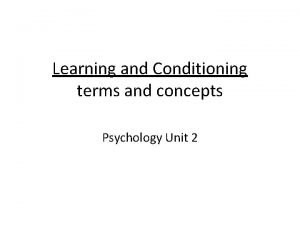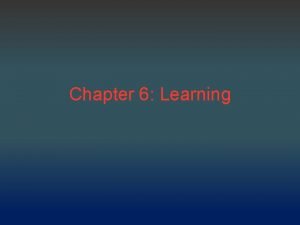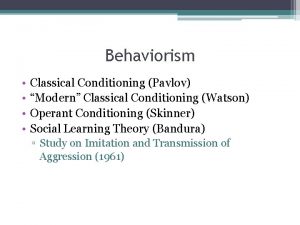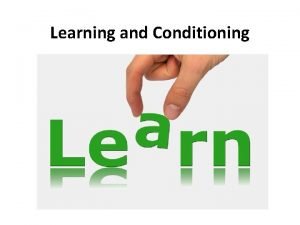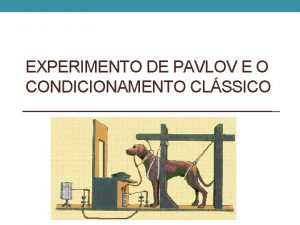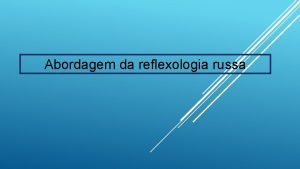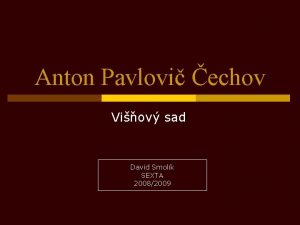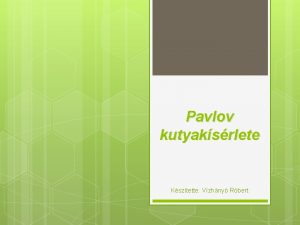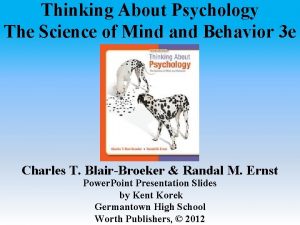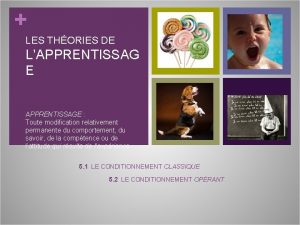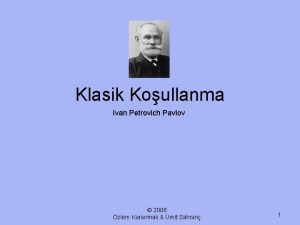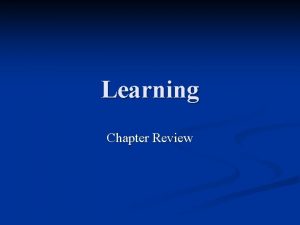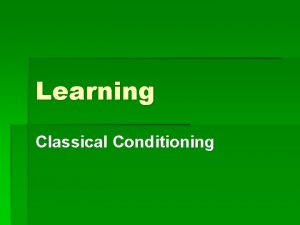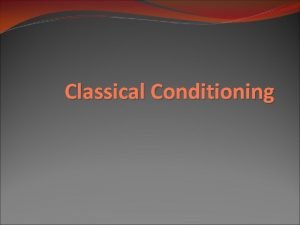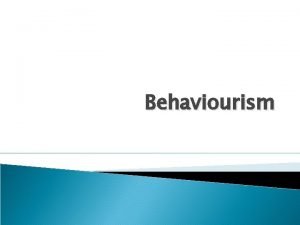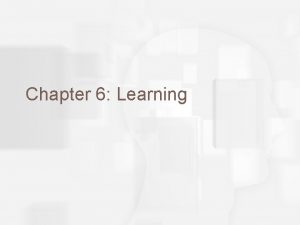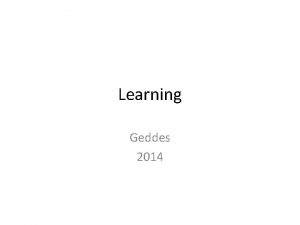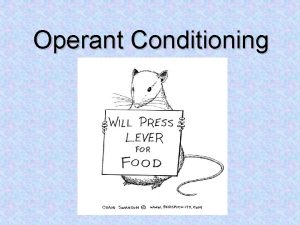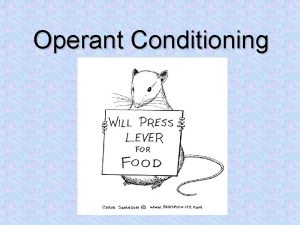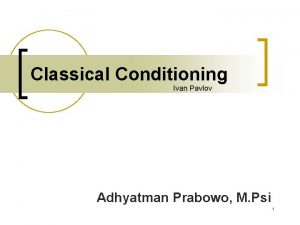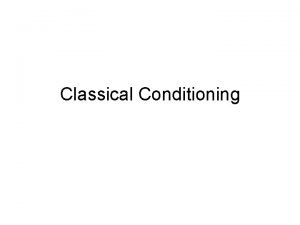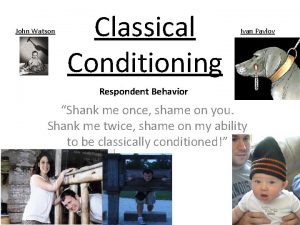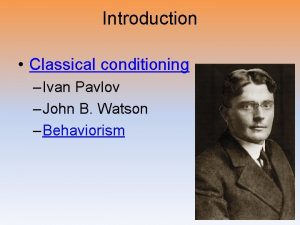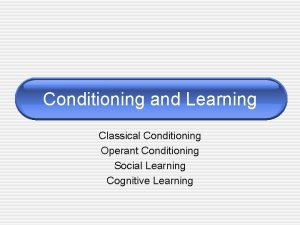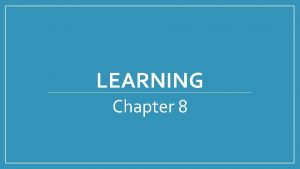Chapter 6 Learning Classical Conditioning Ivan Pavlov Classical























- Slides: 23

Chapter 6: Learning

Classical Conditioning • Ivan Pavlov • Classical Conditioning- a type of learning in which a stimulus acquires the capacity to evoke a response that was originally evoked by another stimulus. • Terminology ▫ Unconditioned Stimulus (UCS)- a stimulus that evokes an unconditioned response without previous conditioning ▫ Unconditioned Response (UCR)- a unlearned reaction to an unconditioned stimulus that occurs without previous conditioning. ▫ Conditioned Stimulus (CS)- a previously neutral stimulus that has, through conditioning, acquired the capacity to evoke a conditioned response. ▫ Conditioned Response (CR)- a learned reaction to a conditioned stimulus that occurs because of previous conditioning

Figure 6. 1 Classical conditioning apparatus

Figure 6. 2 The sequence of events in classical conditioning

Classical Conditioning: More Terminology • 3 types of Classical Conditioning ▫ ___________: CS and UCS begin and end together ▫ ___________CS begins just before the UCS, end together ▫ _________: CS begins and ends before UCS is presented

Classical Conditioning: More Terminology • _____= pairing of UCS and CS ▫ The number of trials needed vary • _____ = initial stage in learning ▫ Depends on stimulus contiguity • ________= occurring together in time and space

Processes in Classical Conditioning • _______ – the gradual weakening and disappearance of a conditioned response • _________the reappearance of an extinguished response after a period of nonexposure to the conditioned response • _________occurs when an organism that has learned a response to a specific stimulus responds in the same way to new stimuli that are similar to the original stimulus.

Processes in Classical Conditioning • ___________occurs when an organism that has learned a response to a specific stimulus does not respond in the same way to new stimuli that are similar to the original stimulus • ____________a conditioned stimulus functions as if it were an unconditioned stimulus

Figure 6. 7 Acquisition, extinction, and spontaneous recovery

Operant Conditioning or Instrumental Learning • Edward L. Thorndike (1913) ▫ Instrumental learning- responding is instrumental in obtaining some desired outcome ▫ the law of ____- if a response in the presence of a stimulus leads to satisfying effects, the association between the stimulus and the response is strengthened • B. F. Skinner (1953) ▫ principle of reinforcement- ▫ _________(Skinner Box)- a small enclosure in which an animal can make a specific response that is recorded while the consequences of the response are systematically controlled. ▫ Emission of response ▫ ____________the circumstances or rules that determine whether responses lead to the presentation of reinforces.

Figure 6. 12 Reinforcement in operant conditioning

Figure 6. 13 Skinner box and cumulative recorder

Reinforcement vs. Punishment and Positive vs. Negative • Reinforcement- response that increases behavior occurrence ▫ Positive Reinforcement▫ Negative Reinforcement • Punishment- response that decreases behavior occurrence ▫ Positive Punishment▫ Negative Punishment▫ -

Basic Processes in Operant Conditioning • Acquisition- • ______- reinforcement of closer and closer approximations of a desired response • Extinction- gradual ______ and _________ of a response tendency because the response is no longer followed by a reinforcer. • Primary Reinforcers ▫ Satisfy biological needs • Secondary Reinforcers ▫ Conditioned reinforcement because they are acquired reinforcing qualities by their association with primary reinforcers

Figure 6. 14 A graphic portrayal of operant responding


Schedules of Reinforcement • Continuous reinforcement • Intermittent (partial) reinforcement▫ ______ schedules �Fixed-ratio schedule – the reinforcer is given after a fixed number of nonreinforced responses �Variable-ratio schedule- the reinforcer is given after a variable number of nonreinforced responses ▫ ______ schedules �Fixed-interval schedule- the reinforcer is given for the first response that occurs after a fixed time interval has elapsed �Variable-interval schedule- the reinforcer is given for the first response after a variable time interval has elapsed.

Figure 6. 17 Schedules of reinforcement and patterns of response

Consequences: Reinforcement and Punishment • Increasing a response: ▫ Negative reinforcement = response followed by removal of an aversive stimulus �_______an organism acquires a response that decreases or ends some aversive stimulation �_______an organism acquires a response that prevents some aversive stimulation from occurring • Decreasing a response: ▫ Punishment ▫ Problems with punishment �Not as influential as ________ �Strong emotional responses exist to physical punishment

Figure 6. 18 Positive reinforcement versus negative reinforcement

Figure 6. 20 Comparison of negative reinforcement and punishment

Changes in Our Understanding of Conditioning • Biological Constraints on Conditioning ▫ Instinctive Drift- occurs when an animal’s response tendencies interfere with conditioning processes ▫ Conditioned Taste Aversion- occurs when a subject associates the taste of a certain food with symptoms caused by a toxic, spoiled, or poisonous substance. • Cognitive Influences on Conditioning ▫ Latent learning- learning that is not apparent from the behavior when it first occurs.

Observational Learning: Basic Processes • Albert Bandura (1977, 1986) ▫ Observational learning- occurs when an organism’s responding is influenced by the observation of others, who are called models ▫ Vicarious conditioning- behavior is the product of observed consequences. • 4 key processes ▫ Attention- must pay attention to another person’s behavior and its consequences ▫ Retention- must store mental representation of what you witnessed in your memory ▫ Reproduction- must convert your stored mental images into overt behavior ▫ Motivation- depends on whether you encounter a situation in which you believe that the response is likely to pay off for you • acquisition vs. performance- reinforcement affects which responses are actually performed more than which responses are acquired.
 Outline pavlov's classical conditioning
Outline pavlov's classical conditioning What was pavlov criticized for ignoring
What was pavlov criticized for ignoring Pavlov classical conditioning
Pavlov classical conditioning Pavlovian conditioning
Pavlovian conditioning Pavlov experiment
Pavlov experiment Operant vs. classical conditioning
Operant vs. classical conditioning Little albert
Little albert Partial schedule of reinforcement
Partial schedule of reinforcement Classical and operant conditioning.
Classical and operant conditioning. Fixed interval
Fixed interval Classical vs operant
Classical vs operant Secondary reinforcer psychology definition
Secondary reinforcer psychology definition Classical and operant conditioning.
Classical and operant conditioning. Classical conditioning vs operant conditioning
Classical conditioning vs operant conditioning Operant conditioning classical conditioning
Operant conditioning classical conditioning Ivan pavlov experimento
Ivan pavlov experimento Ivan pavlov reflexologia
Ivan pavlov reflexologia Ivan pavlovič pavlov
Ivan pavlovič pavlov Pavlov reflexologia
Pavlov reflexologia Pavlovian
Pavlovian Ivan pavlov
Ivan pavlov Klasino
Klasino Ivan pavlov is most closely associated with
Ivan pavlov is most closely associated with Secondary reinforcement psychology definition
Secondary reinforcement psychology definition

